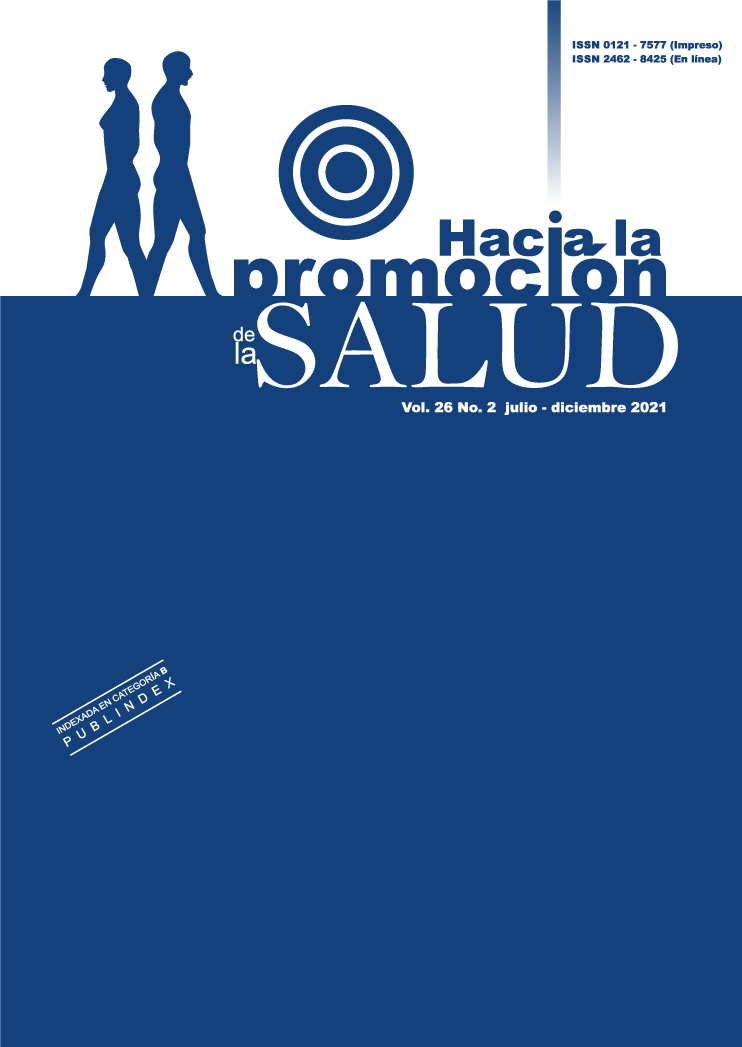Authors
Abstract
Objective: to interpret the perception of public health nurses when they provide the Embera Chami Indians with culturally competent care. Materials and Method: interpretative ethnography with participant observation and ethnographic interviews. The participants were three public health nurses who work in an intercultural Institution providing health services. The analysis followed Leininger’s proposal with support from Atlas ti and Excel. Results: the category “happy nurses with their work, extending this feeling to the personal field by creating bonds of affection with the indigenous Embera Chami” emerged and it was sustained with three subcategories. Conclusion: the public health nurses enjoy the work activities specified by the intercultural Institutions providing health services, they also enjoy the daily life offered by the work environment and the municipal situation characterized by the presence, socialization and interrelation with the Embera Chami indigenous people.
Keywords:
References
2. Ogbolu Y, Scrandis DA, Fitzpatrick G, Newhouse R. Leading organizational cultural competency: Nurse leader rounds and care for diverse patients. J Nurs Adm. [Internet].2016;46(12):627–9. Available from: http://dx.doi.org/10.1097/NNA.0000000000000417
3. Pérez Quintero C, Carrasquilla Baza D. Relación enfermera-paciente frente a la diversidad cultural. Una mirada en situaciones de cuidado a pacientes indígenas. Index de Enfermería. [Internet]. 2018;27(4):216–20. Available from: http://scielo.isciii.es/scielo.php?script=sci_arttext&pid=S1132-12962018000300008&lng=es
4. Transcultural C.A.R.E Associates. The Process Of Cultural Competence In The Delivery Of Healthcare Services [Internet]. 2015. Available from: http://transculturalcare.net/the-process-of-cultural-competence-in-the-delivery-of-healthcareservices/
5. McFarland M, Wehbe-Alamah H. Leininger´s Culture Care Diversity and Universality a Worldwide Nursing Theory. 2015. 1–612 p.
6. Herrero-Hahn R, Rojas JG, Ospina-Díaz JM, Montoya-Juárez R, Restrepo-Medrano JC, Hueso-Montoro C. Cultural Adaptation and Validation of the Cultural Self-Efficacy Scale for Colombian Nursing Professionals. J Transcult Nurs.[Internet].2017;28(2):195–202. Available from: https://doi.org/10.1177/1043659615613419
7. Loftin C, Hartin V, Branson M, Reyes H. Measures of cultural competence in nurses: an integrative review. Sci World JournalWorldJournal. [Internet]. 2013 Jan;1–10. Available from: https://dx.doi.org/10.1155%2F2013%2F289101
8. Ogbolu Y, Scrandis DA, Fitzpatrick G. Barriers and facilitators of care for diverse patients: Nurse leader perspectives and nurse manager implications. J Nurs Manag. [Internet].2018;26(1):3–10. Available from: https://doi.org/10.1111/jonm.12498
9. Joo JY, Liu MF. Nurses ’ Barriers to Care of Ethnic Minorities : A Qualitative Systematic Review. West J Nurs Res. [Internet].2019;1(26). Available from: https://dx.doi.org/10.1177/1054773819885952
10. Orozco Castillo L, López-Díaz L. Cuidado culturalmente competente: puntos de vista de enfermería de salud pública e indígena. Investig Andin. 2020;22(40):35–49.
11. Rojas JG, Herrero-Hahn R. Changing Home: Indigenous when Receiving Care in Hospital. Investig y Educ en Enferm. [Internet].2020;38(3). Available from: https://doi.org/10.17533/udea.iee.v38n3e08
12. Ruiz-Lurduy R, Rocha-Buelvas A, Pérez-Hernández E, Córdoba-Sánchez C. Desarrollo social y salud pública. Reflexiones en torno a la interculturalidad. Rev Fac Nac Salud Pública. [Internet].2016;34(3). Available from: https://doi.org/10.17533/udea.rfnsp.v34n3a12
13. Lozano-Ordoñez E, Salazar-Henao M. Evolución historico-política de la salud indígena en Caldas: Aproximación a la determinación en salud. Hacia Promoc. Salud. [Internet].2018;23(1):125–40. Available from: https://doi.org/10.17151/hpsal.2018.23.1.9
14. Peña Redondo MI, Velásquez Gutiérrez VF. Comprendiendo el significado del puerperio para las indígenas embera katíos de Tierralta, Córdoba, 2018. Hacia Promoc. Salud. [Internet].2020;25(2):94–108. Available from: https://doi.org/10.17151/hpsal.2020.25.2.11
15. Orozco Castillo ML, López-Díaz AL. Competencia cultural de enfermeras en salud pública con población indígena. Av en Enfermería. [Internet]. 2019;37(1):9–18. Available from: http://dx.doi.org/10.15446/av.enferm.v37n1.6851316. Guber R. La etnografía. Método, campo y reflexividad [Internet]. 2011. 1–160 p. Available from: https://abacoenred.com/wp-content/uploads/2016/01/etnografi-a-Me-todo-campo-reflexividad.pdf
17. Campinha-Bacote J. The Process of Cultural Competence in the Delivery of Healthcare Services: a model of care. J Transcult Nurs. [Internet]. 2002;13(3):181–4; discussion 200-1. Available from: https://doi.org/10.1177/10459602013003003
18. Reina-leal LM, López Díaz L. Entrelazando la compasión y la competencia cultural en hospitalización : Una revisión de experiencias. Cult los Cuid Rev Enfermería y Humanidades. [Internet].2020;3(58):136–53. Available from: https://doi.org/10.14198/cuid.2020.58.13
19. Berlin A, Johansson S-E, Törnkvist L. Working conditions and cultural competence when interacting with children and parents of foreign origin--Primary Child Health Nurses’ opinions. Scand J Caring Sci [Internet]. 2006 Jun;20(2):160–8.Available from: https://doi.org/10.1111/j.1471-6712.2006.00393.x
20. Whitman M V, Davis J a. Registered nurses’ perceptions of cultural and linguistic hospital resources. Nurs Outlook [Internet]. 2009 [cited 2013 Aug 14];57(1):35–41. Available from: https://doi.org/10.1016/j.outlook.2008.07.001
21. Swanson C. The Case for Studying Cultural Competence from the Perspective of the Hispanic Immigrant Patient: A State of the Science. Online J Cult Competence Nurs Healthc. 2012;2(1):1–9.
22. Starr S, Wallace D. Client Perceptions of Cultural Competence of Community-Based Nurses. J Community Health Nurs. [Internet]. 2011;28(2):57–69. Available from: https://doi.org/10.1080/07370016.2011.564057
23. Orozco Castillo L, López Díaz L. Percepción del cuidado de enfermería por indígenas Embera. Rev Cienc y Cuid. [Internet].2019;16(2):72–82. Available from: https://doi.org/10.22463/17949831.1609
24. Prieto DM, Apraez NG, Colombiana A. Análisis del diálogo intercultural en la prestación de servicios de salud en la Amazonía Colombiana. Rev Iberoam Enfermería Comunitaria. 2018;11(1):37–43.
25. 25. Matteliano MA. Provider´s Perspectives on Cultural Competence in Ethnically Diverse Primary Care Practices. J Fam Med Dis Prev. 2015;1(3):1–5.
26. Hagman L. How New Mexico licensed registered nurses gained cultural self-efficacy and their stories. J Cult Divers. [Internet].2007;14(4):183-91.Available from: https://pubmed.ncbi.nlm.nih.gov/19172984/
27. Matteliano MA, Street D. Nurse practitioners’ contributions to cultural competence in primary care settings. J Am Acad Nurse Pr. [Internet]. 2012;24(7):425–35. Available from: https://doi.org/10.1111/j.1745-7599.2012.00701.x
28. Purnell L. The Purnell Model for Cultural Competence. J Transcult Nurs [Internet]. 2002 Jul;13(3):193–6; discussion 200- 1. Available from: https://doi.org/10.1177/10459602013003006

 pdf (Español (España))
pdf (Español (España))
 FLIP
FLIP
 Perfil Google Scholar
Perfil Google Scholar























